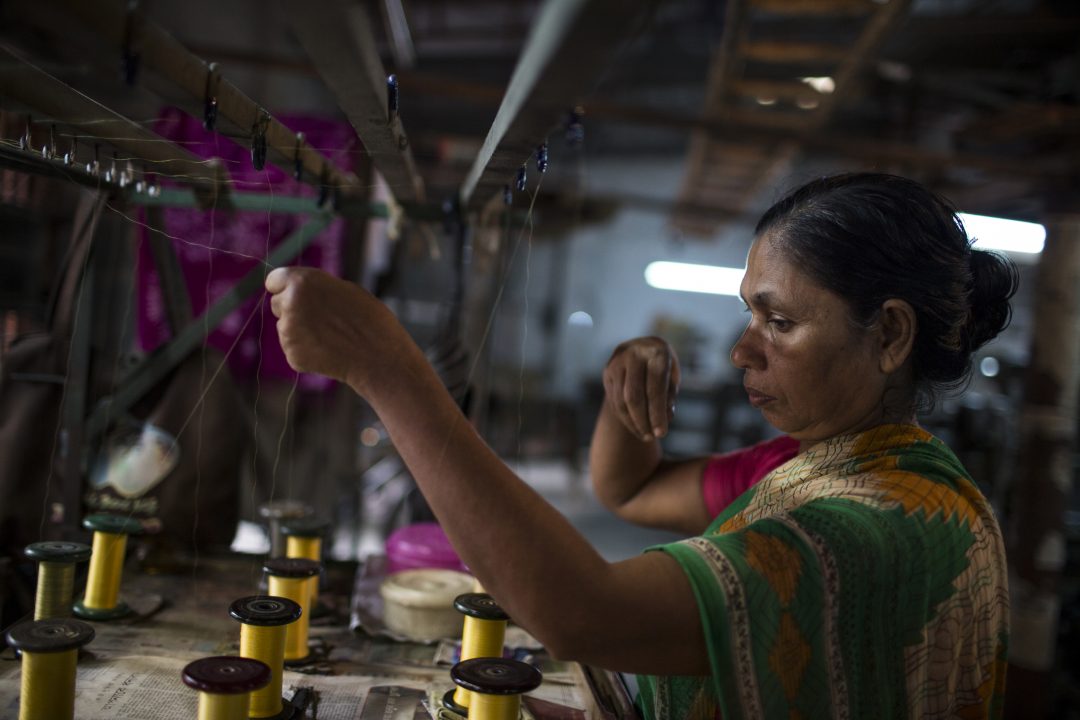May 9, 2018

Bangladesh’s garment sector employs around 3.6 million workers and attracts thousands of rural residents, many of whom are women. Photo/Conor Ashleigh
Khatun grew up in the northern part of Bangladesh. When she was 15 years old, she was forced to marry a man twice her age. In a low, shaking voice she described to me how he had physically abused her and forbid her to work. She said she longed to escape the suffering and the chance to make her own living.
In what seems an impossibly brave decision, Khatun left her husband and traveled with her two children to Dhaka in search of work. For a young woman from a low-income area, this frequently means looking for a job in one of the country’s 4,500 garment factories that employ around 3.6 million workers and attract thousands of rural residents like Khatun in search of a better life for themselves and their families. But Khatun would quickly realize the reality women face in the workplace. She described how, despite women making up the majority of workers in the factory, she faced constant provocation from her male coworkers who criticized her for leaving her husband and harassed her on her way home. Once again, she longed for more, and was determined to chart a path with more potential.
As a graduate of the regional Asian University for Women (AUW) in Chittagong, in 2015, I was hired to launch Pathways for Promise, an intensive, five-year undergraduate program designed to attract students from communities that remain underserved. Pathways specifically targets women who are the first in their family to enter university and come from disadvantaged backgrounds such as daughters of micro-finance borrowers, historically neglected ethnic minorities, ready-made garment factory workers, and refugees. I spent eight months at the factories interviewing hundreds of women to find potential recruits for the program. This is how I met Khatun.
My schedule those days was hectic. Often the only time the factory owners would allow me to conduct the university entrance exams and interviews was very late in the night when the women’s shifts had ended. I spent my days in constant negotiation with the factory owners, because while the program provided free tuition and living expenses, we had to ensure that they would continue to receive their salaries, as most of the women had children and were the sole earners in their households. In a sector that often overlooks even the most basic things like safety measures, convincing them to pay the workers while they got an education was enormously challenging.
These interviews turned into life lessons for me. I heard hundreds of stories of heartbreak and hope from women who had endured child marriages, domestic violence, and marital rape. Like Khatun, most of them were from remote villages who had either escaped abusive families or had come to the city in search of a job when the sole earner of the family had died. They never got a chance to pursue higher education, nor were they expected to. Yet many of them still held dreams of one day going to university.
It was agonizing that we could only offer the positions to a handful of so many deserving candidates. In eight months, I recruited 50 candidates out of 650 applicants. In March 2016, the first batch of students joined our campus. During the first week of orientation, many of them came to me to tell me that they were living their dreams already.
Within a year, one of the students had already been selected to attend a global conference in Spain. Another student published a research paper in an international journal on microcredit and poverty in Bangladesh. Others attended exchange student programs across the world and engaged in voluntary activities around the city. Today, Pathways for Promise has more than 100 students enrolled.
Back in our interview room, I asked Khatun what she would plan to do after she graduated from the program.
“I will still come back to this factory where I am now a daily laborer. But with an education, I will have the confidence and skills to fill a more advanced position where people would show me respect.”
As for Khatun’s exam? She aced it.
Mowmita Basak is a 2015 Asia Foundation Development Fellow and founder and president of the Center for Leadership Assistance & Promotion (CLAP) Foundation, which develops training and mentorship programs for young leaders to serve minority communities for a more inclusive Bangladesh. Mowmita recently completed her master’s degree in Public Policy at University of Oxford.
Read more about The Asia Foundation Development Fellows Program.
